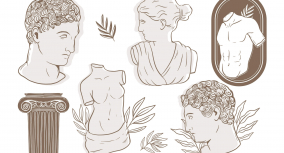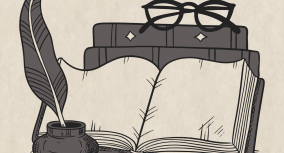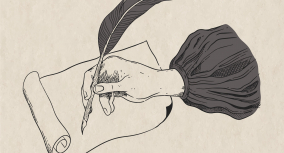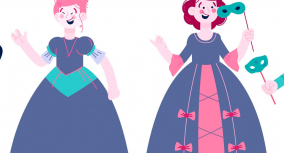There are several symbols in Hamlet that are crucial for understanding the underlying message of the play. They provide a more in-depth look into the characters’ minds, illustrating their emotions and sufferings. Besides, symbols and imagery reveal how the inner turmoils affect the world around.
So, examine the symbolism in Hamlet with the help of the following sections:
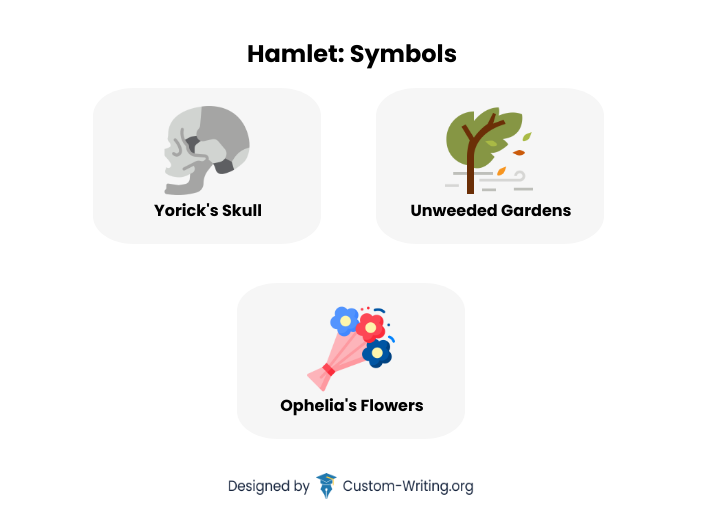
Yorick’s Skull and the Graveyard
In Hamlet, Yorick’s skull represents two things. First, it’s an inevitability of death and existential emptiness of life. Second, the skull is an attachment of Hamlet to Yorick, his father’s court jester. He died when Hamlet was only seven years old.
The human skull appears after a pair of gravediggers toss it away. They work happily despite their job being dramatic and directly connected to death. The gravediggers bring up the play’s most important topics in their short appearance. They elaborate on death, love, politics, religion, and suicide. They use Ophelia’s passing to debate about suicide, speaking about it comically and casually.
When Hamlet finds the skull, he questions whose it is. The gravediggers explain that it belonged to Yorick. For Hamlet, this finding represents a point of no return. He says, “Alas, poor Yorick! I knew him, Horatio, a fellow of infinite jest, of most excellent fancy.”
He understands that it does not matter how a person lived if he was a king or a jester, good or evil. All of us will eventually die and return to dust. Therefore, the graveyard represents an equalizer. In the face of death, everyone is alike as it destroys differences between social classes and statuses.
For Hamlet, the graveyard scene is the turning point in which he changes his attitude towards death. He understands its inevitability and the eventual disintegration of the body.
Hamlet demonstrates his emotional attachment to Yorick. There is more description of his relationships with the jester than with the Old Hamlet. Thus, in the play, Yorick also represents a paternal figure for Hamlet.
Quotes about Yorick’s Skull
It must be ‘se offendendo;’ it cannot be else. For
Hamlet, Gravedigger, Act 5, Scene 1
Here lies the point: if I drown myself wittingly,
It argues an act: and an act hath three branches: it
Is, to act, to do, to perform: argal, she drowned
Herself wittingly.
That skull had a tongue in it, and could sing once:
Hamlet, Hamlet, Act 5, Scene 1
How the knave jowls it to the ground, as if it were
Cain’s jaw-bone, that did the first murder!
Alas, poor Yorick! I knew him, Horatio: a fellow
Hamlet, Hamlet, Act 5, Scene 1
of infinite jest, of most excellent fancy: he hath
borne me on his back a thousand times;
The queen, the courtiers: who is this they follow?
Hamlet, Hamlet, Act 5, Scene 1
And with such maimed rites? This doth betoken
The corse they follow did with desperate hand
Fordo its own life: ’twas of some estate.
Couch we awhile, and mark.
Unweeded Gardens
In Act 1, Scene 2, in his first soliloquy, Hamlet compares the world and humanity in it with “an unweeded garden.” The world around the protagonist crumbles, and he cannot ignore it right away. Shakespeare uses nature imagery in Hamlet to illustrate the state of affairs. It demonstrates both Denmark and the hero’s mind.
Right away, Hamlet compares his life with an unweeded garden, which was beautiful back in the days. Through this metaphor, Hamlet expresses deep dissatisfaction with his own life and his melancholy. He also reveals his thoughts about the state of Denmark that is filled with weed, being “rank and gross in nature.”
This symbol is interconnected with Marcellus’ remark, “something is rotten in the state of Denmark.” This expression shows that something evil is going on, making the country decay from the inside. Thus, the “unweeded garden” in Hamlet is juxtaposed with the Garden of Eden. Its peace and perfection were undermined from within as well.
The best example of the “gross” human being in Hamlet is Claudius. In Act 3, Scene 3, Claudius says, “o my offense is rank it smells to heaven It hath the primal eldest curse upon’t.” In this speech, he confesses his guilt for the murder of his brother. The character compares himself to Cain, saying, “the primal eldest curse upon’t.”
When Ghost talks about the murder, he also uses the Garden of Eden analogy. Claudius is compared with the serpent and the paradise that was lost because of the lies. Due to Claudius’ wicked acts, the whole of Denmark is getting rotten.
Quotes about Unweeded Gardens
’tis an unweeded garden
Hamlet, Hamlet, Act 1, Scene 2
That grows to seed; things rank and gross in nature
Possess it merely.
Something is rotten in the state of Denmark.
Hamlet, Marcellus, Act 1, Scene 4
But know, thou noble youth,
Hamlet, Ghost, Act 1, Scene 5
The serpent that did sting thy father’s life
Now wears his crown.
O, my offense is rank, it smells to heaven,
Hamlet, King Claudius, Act 3, Scene 3
It hath the primal eldest curse upon’t—
A brother’s murther.
Confess yourself to heaven,
Hamlet, Hamlet, Act 3, Scene 4
Repent what’s past, avoid what is to come,
And do not spread the compost on the weeds
To make them ranker.
Ophelia’s Flowers
In the play, Shakespeare relied on the audience’s knowledge of herbs and the hidden meanings they carry. When Ophelia goes mad, she starts handing out flowers. However, she was not handing them out chaotically. Each flower in Hamlet represents something. So, when she was giving flowers to people, she was trying to express her inner feelings.
For instance, when she offers rosemary, she says, “there’s rosemary, that’s for remembrance, pray you, love, remember.” She hands this flower to Laertes, her brother. The smell of rosemary is very strong. Therefore, she attaches a meaning of long-lasting memory to it. By giving it to him, she asks him to remember her.
Another flower that she offers is fennel, explaining what the flower symbolism is. She offers it to Claudius, and it symbolizes adultery. However, it is not the only flower she gives to the King. Ophelia gives him columbines, which also symbolizes adultery. Some critics believe she offers this to Gertrude as fennel and columbines represent ingratitude.
The third fower that she carries is rue. It is a bitter-tasting herb and can symbolize disdain. This flower most probably was left for Ophelia. For her, it represents sorrow and bitterness of grief.
Her brother understands the flower imagery, as can be seen from his earlier remark. Laertes compares Hamlet’s love with a violet, which is very quick to bloom and die. He doesn’t trust the protagonist, expecting him to break his sister’s heart. This is the first time when flowers appear in the play.
Nevertheless, in Ophelia’s bouquet of madness, violets represent faithfulness, while daisies represent “an unhappy love.” Quite often, critics compare Ophelia’s youth and sexuality with the flower, showing that she is ready to reproduce.
Quotes about Ophelia’s Flowers
A violet in the youth of primy nature,
Hamlet, Laertes, Act 1, Scene 3
Forward, not permanent- sweet, not lasting;
The perfume and suppliance of a minute;
No more.
There’s rosemary, that’s for remembrance.
Hamlet, Ophelia, Act 4, Scene 5
Pray you, love, remember. And there is pansies,
that’s for thoughts.
There’s fennel for you, and columbines.
Hamlet, Ophelia, Act 4, Scene 5
There’s rue for you, and here’s some for me; we
may call it herb of grace o’Sundays.
There’s a daisy. I would
Hamlet, Ophelia, Act 4, Scene 5
give you some violets, but they withered all when
my father died. They say he made a good end.



![Hamlet Themes: Death, Revenge, & Others [With Quotes]](https://custom-writing.org/blog/wp-content/uploads/2021/02/Themes-284x153.jpg)

